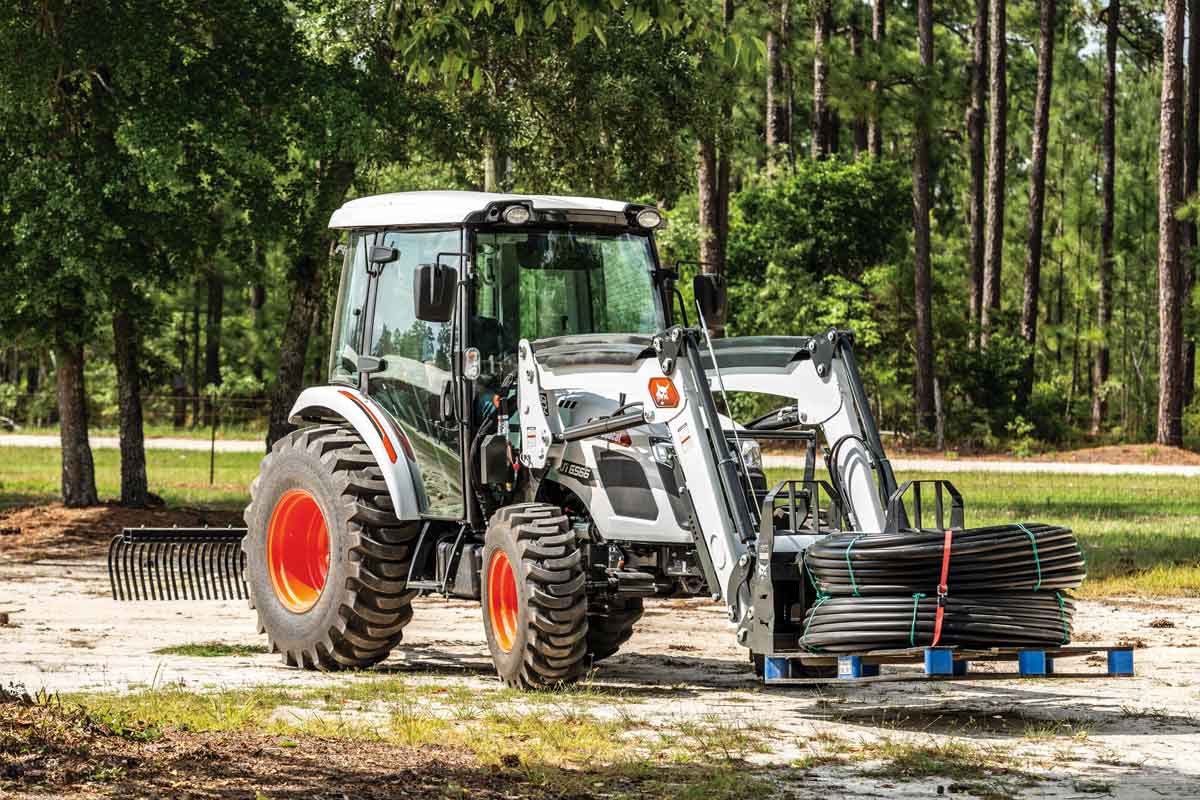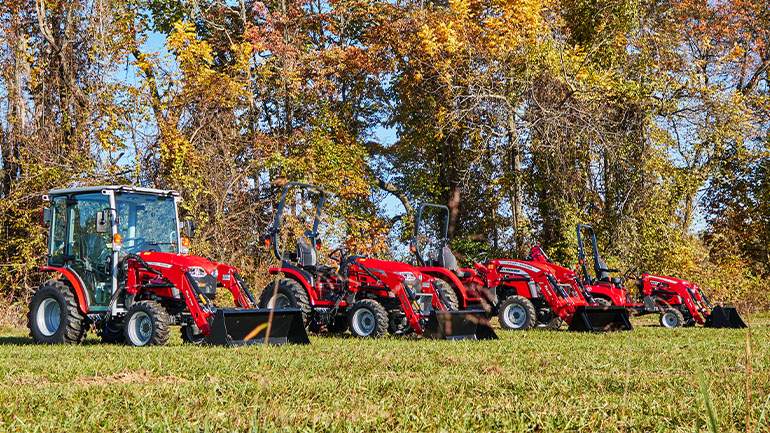Today’s Utility Tractors Are Techy: Hydrostat Transmissions, Third-Function Valves, Self-Leveling and More

Utility tractors are the classic piece of compact equipment. Small chore tractors have been around for a hundred years, utilizing time-honored technologies like the power-take off system and the gear transmission to tackle tough applications from property maintenance and snow removal to livestock care and hobby farming. Of course, just because a type of machinery is still popular for multiple generations of operators doesn’t mean it’s old fashioned or antiquated. Utility tractors today are sophisticated pieces of equipment that can be outfitted with hydrostatic transmissions or air-conditioned cabs or offered with automation like self-leveling and even apps to track maintenance and provide security.
There is much to understand when picking and choosing a new compact tractor for 2023 operations and beyond. Attachments, attachment systems, transmissions, cab environments, maintenance protocols, operational features and connection to the cloud are changing the experience of owning and operating a utility tractor, which we’ll randomly categorize as units between 40 and 60 PTO hp and below. Let’s start with…
Transmissions and Automation like Cruise Control

Transmission choices alone are varied and complex on tractors today. Heritage gear-driven transmissions are designed to lock a tractor into one speed and are typically better suited for sloping and rough terrain. It’s an affordable option that allows for maximum tractor PTO performance, and today there are a variety of gear-driven variants — sliding gear, collar shift, synchro and power shift.
Not to be confused with power shift, “power shuttle transmissions” combine hydraulic clutch packs with electronic controls to offer a clutch-less option to engage the transmission for repetitive forward and reverse maneuvers. This option offers the strength, power and reliability of a mechanical transmission without all the manual input involving hands, feet and legs. The most popular tranny in the industry is the hydrostatic transmission, which uses hydraulic fluid to power drive gears and axles, and this type of transmission is the most popular among compact tractors particularly thanks to its smooth ride and ease of use.
In the compact utility world, hydrostatic transmissions have consumed the under-60 hp market by offering simplified operation and adequate torque to handle most tasks. As an example: John Deere’s hydro transmission with twin touch pedals, which is standard on its 1 Series, 2 Series and 3E Series models, is built for ease of use, with options for customizing operator comfort. “It provides easy side-by-side pedals for forward and reverse,” says Mark Davey, go-to-market manager, compact utility tractors, at John Deere.
Some Deere models have an option for cruise control. Their 3R, 4M Heavy Duty and 4R models offer a more advanced transmission — the eHyrdo — which delivers even more options for customizing tractor operations with a control pad. “Motion Match helps you customize how quickly the transmission starts and stops as you press or release the pedals,” Davey elaborates. In addition, Load Match helps prevent engine stalling in tough load situations, and the cruise control and Speed Match help set the exact speed needed for the task at hand.
According to Joel Hicks, senior product support manager for Kioti, mechanical transmissions with a synchronized or hydraulic shuttle still have a place in the market — and even offer some advantages in applications where precise speed or heavy towing and torque are required. “The most complicated transmission would be the CVT or IVT, which is a combination of hydraulic- and mechanical-driven powertrain.” He says these are more sophisticated and typically found in higher horsepower applications.
Massey Ferguson compact tractors are available with a range of transmission options, allowing operators to pick the transmission style they are most comfortable with, whether that’s a solid 8 X 8 gear-style Synchro Shuttle, ideal for those who just want to put it in gear and go, or its premium hydrostatic transmission.
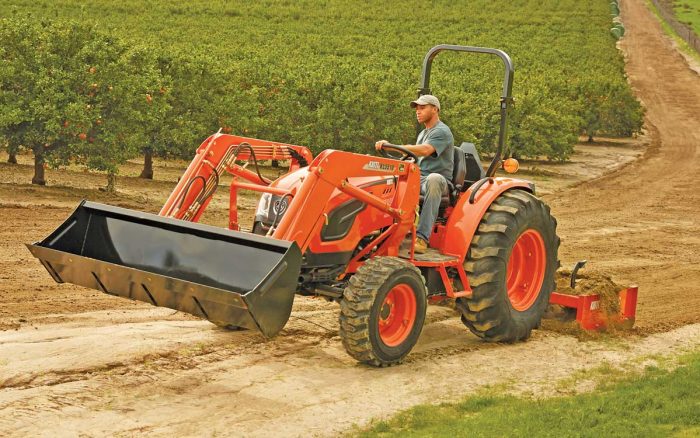
“The premium hydrostatic transmission, available on our M Series compact tractors, employs an automatic throttle in addition to a hand throttle,” says Adam Sills, marketing product specialist for Massey Ferguson North America. “For example, without the automatic throttle feature, the operator would need to manually rev a traditional hydrostatic transmission to reach the desired speed.”
Massey Ferguson’s premium hydrostatic transmission also includes: cruise control, which effortlessly maintains speed during applications; max speed control dial, which allows operators to set a max speed limit for an application; response control dial, which tunes the pedal sensitivity to the operator’s comfort and is great for operations with multiple users; and SoftStart, an electronic modulation system that allows for slow PTO engagement, slowly engaging implements for a smoother, less demanding startup.
Compact Tractor Buying Advice
“Do your homework,” urges Joel Hicks, senior product support manager for Kioti. Many customers make purchases based on the information they find on the internet, but he advises them to take extra steps. “Look at the product, operate it, speak with the representing dealers.” The opportunity to touch and see how the machine operates and discuss usage with a qualified representative can help customers make the correct purchase and be satisfied with their decision. Customers should spec a new compact tractor to fit specific applications and operation goals, adds Adam Sills, marketing product specialist, Massey Ferguson. “Sometimes this might include a bit more horsepower if there is planned growth, or maybe it’s adding a third-function diverter and grapple because brush clearing is going to be a common occurrence. The key is finding the right combination of features to fit your needs and budget.” As with any equipment purchase, it’s important to work with a dealer or manufacturer you trust.
Luxury in the Cabin

Sales of cabin tractors in the compact utility market continue to increase. According to Sills, Massey Ferguson sees the most demand for its deluxe cab. “Customers interested in this feature are usually located in the northern part of the country with lots of snow and cold temps,” he notes. “We understand that in some parts of the country, working in an open-station tractor just isn’t practical. That’s why we offer a cab option on the MF 1800 M Series and MF 2800 M Series. Standard cabs feature heating and air conditioning for a comfortable ride and work lights. An XM satellite radio can also be installed through Agco Parts.”
Massey Ferguson’s deluxe cab for the MF 1800 M and MF 2800 M Series features an air-ride seat, rear defroster and Bluetooth-capable radio. It comes standard with LED work lights and brake lights. This provides better visibility for those operating along roadways in the early morning or late evening.
“Our designs are farmer focused to provide visibility, comfort and efficiency,” Sills says. For example, the ergonomic studies that went into the cab layout for the MF 8S Series helped determine the integration and placement of the loader joystick and controls on the smaller tractors to be close at hand and easy to operate. Flat operator platforms provide ample legroom and optimal comfort.
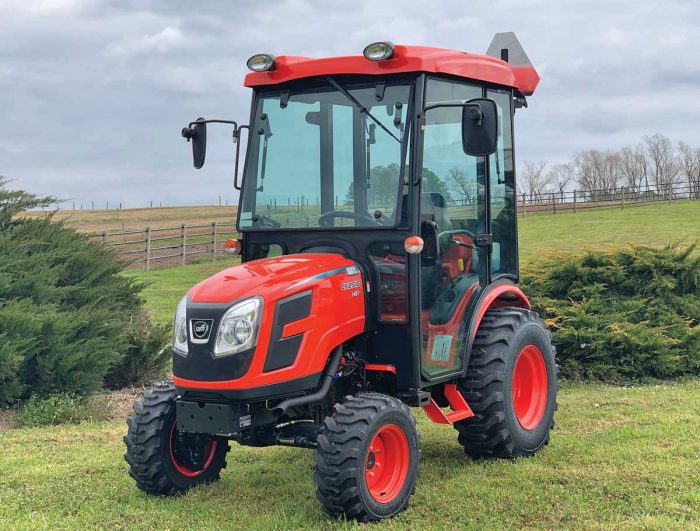
Beyond weather factors, Joel Hicks, senior product support manager for Kioti, says people who create a lifestyle outside of their daily 9-to-5 routine and have funding to purchase higher luxury machines are driving sales. “Customers continue to look for additional options and accessories that simplify their ability to complete chores or make their work environment more pleasurable.” Thus, many Kioti machines have luxury options like heated or cooled cabs and wireless audio players.
John Deere’s new 4075R comes standard with a cab, including heat and air conditioning, with an optional radio with Bluetooth technology to keep operators connected to their favorite tunes, news or podcasts. This tractor also comes standard with a new heavy-duty front axle built to hold up to commercial grade jobs, says Davey. LED headlights and work lights are also standard.
Say Yes to Self-Leveling

Self-leveling is a great tool for repetitive loader use because it allows the operator to focus on operating the loader without having to constantly divert attention to the position of the bucket, pallet forks or the load being handled. “A non-self-leveling loader requires the operator to visually focus on the load, as well as the loader operation and to level the load more frequently during operation than a self-leveling loader,” Hicks says.
Self-leveling loaders can help inexperienced operators perform like a pro. On Deere’s mechanical self-leveling loader, the loader bucket will maintain a level position through the full height of the loader. “Plus,” Davey adds, “you get increased lift capacities, easy visibility of the bucket level indicator on the loader boom to help determine the position of the front implement and reduction of materials lost during operation.”
Popular on Massey Ferguson’s mid-range tractors, particularly the MF 5S and the MF 6S Series, self-leveling technology helps ensure loads like hay bales or pallets of feed stay level through lifting, stacking or transport. For material handling, such as dirt work or brush hauling, maintaining a level load isn’t critical, meaning most compact utility tractor operators don’t need the precision or extra cost of self-leveling technology, Sills says. “At the end of the day, we always recommend customers carefully consider their intended applications and connect with their local dealer on the right set of features for their operation without over investing.”
While non-self-leveling loaders may be more cost-effective, have better visibility and move faster, self-leveling loaders have advantages, such as ease of operation. Hicks observes that the self-leveling loader is more common on tractors around 70 hp and above, where price, speed and visibility are easier to absorb or engineer into the product.
Third-function Valves for Hydraulic Attachments

Third-function valves provide the ability to power hydraulic attachments via a compact utility tractor. Widely used in the construction industry, this technology has now crossed over to the agricultural and consumer markets. To enhance the functionality of the 1E, 1R and 2025R John Deere tractors, third-function loader and tractor bundles are available. Davey says, “This adds versatility to the tractor and loader package, enabling the use of attachments such as four-in-one buckets, root grapples and hydraulic angling blades.”
Kioti offers “live” third-function kits for most of its product line, other than some sub-compact models. These enable an operator to utilize the loader joystick to control the four main loader functions (lift, lower, rollback, dump) and the attachment functions by depressing buttons or switches on the handle. “This means simplified operation and the ability to perform multiple functions at the same time,” Hicks summarizes. The “live” option offers more loader functionality and more complicated operation than a lower featured third-function that requires the operator to depress a switch while using the joystick to operate the attachment.
Massey Ferguson offers a similar feature, with an optional third-function diverter with a button on the joystick that diverts the loader’s curl function into a squeeze function for use with a grapple or four-in-one bucket. “This feature is increasingly popular with compact utility operators as more and more customers look to expand their equipment’s versatility,” Sills says.
While it’s not a feature he thinks every customer needs, Sills believes a third-function diverter is useful for landscapers, contractors and municipalities when moving gravel and aggregates or pulling brush.
Take a break from reading and check out our Machine Heads video series!
More Tech to Come
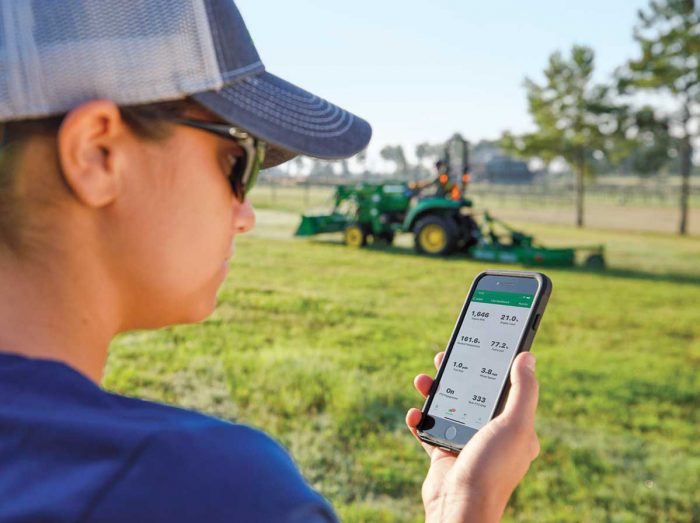
Technology is steadily increasing on smaller tractors from innovative attachment systems and phone apps to hydraulic implements and joystick controls. Tier 4 Final engines offer greener operations with high pressure common rail fuel injection systems, diesel oxidation catalysts and diesel particulate filters. Telematics technologies are creeping down into smaller tractor models, allowing owners to geofence, track maintenance intervals and ensure machine longevity. From LED lights to digital displays, utility tractors continue to become more advanced yet easy to use and maintain. And let’s not forget to mention the increase in service intervals and maintenance access for units. From easy-to-remove engine side panels that speed up access to the engine compartment to onboard self-diagnostic capabilities, service is being simplified.
A compact utility tractor is a wonderfully adaptable machine that can take your jobsite productivity to the next level. Getting the right machine is really a matter of carefully considering your requirements and talking with your local dealer to mix and match powertrain specs and attachments with them in mind. The key is finding that right partner, and then picking the right technologies to take your tractor operations to the next level.
Lori Lovely is a freelance writer for Compact Equipment.
Drive-Over Mower Decks

The advantage of a drive-over mower deck is the ability to remove it without having to push or pull it while it’s under the tractor. It’s a convenient option for some customers. They can be easier to install and remove than other mower decks. Joel Hicks, senior product support manager for Kioti, describes the process: approach the tractor and line up; engage the four-wheel drive and drive over the deck; lower the three-point hitch/mower lift mechanism; turn off the engine before connecting the mower and the PTO; go mow; and then repeat in reverse order to remove.
Massey Ferguson offers a drive-over mower deck option for the MF GC1700 Series. “The sub-compact size of this tractor makes a drive-over option beneficial since positioning and installing the mower deck from the side of the tractor might be difficult for some target customers,” explains Adam Sills, marketing product specialist for Massey Ferguson North America. Similarly, the John Deere Autoconnect Drive-Over Deck offers the convenience of quickly installing or removing the mower deck. “With minimal time and effort, our industry-leading technology requires no ramps or complicated connection process,” says Mark Davey, go-to-market manager, compact utility tractors, John Deere.


